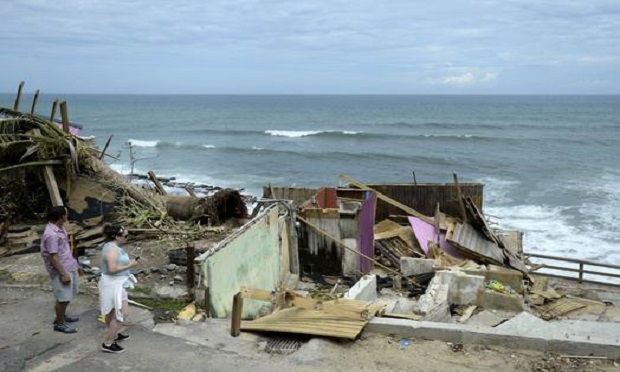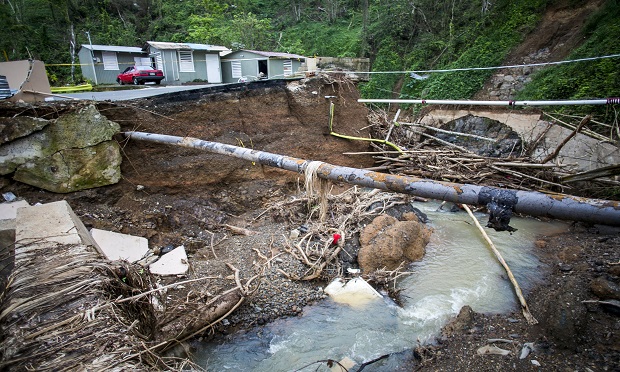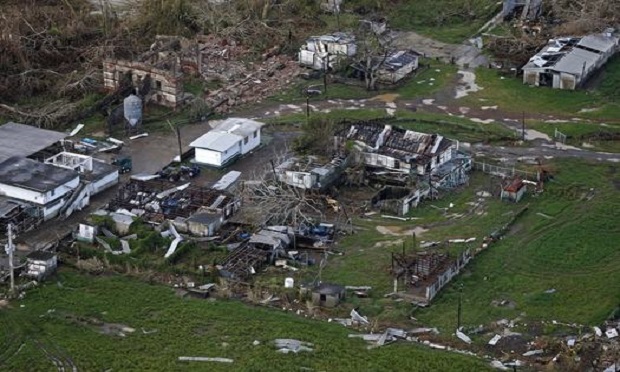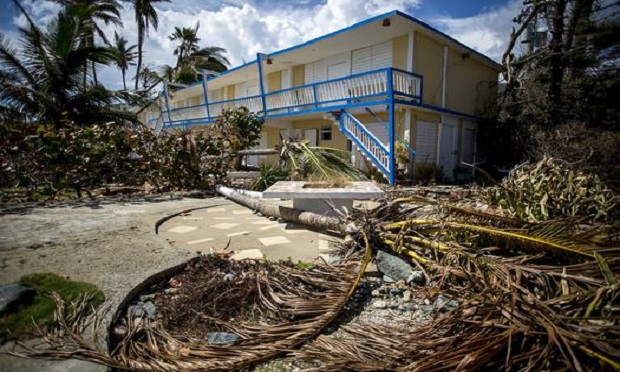Tropical Storm Dorian is gaining strength as it approaches the Lesser Antilles and is forecast to skirt Puerto Rico as a weak hurricane. The storm was about 30 miles (50 kilometers) east-southeast of Barbados as of 8 p.m. New York time. With maximum sustained winds of 60 miles per hour, Dorian is expected to drop 3 to 8 inches on the islands of Martinique, St. Vincent and Barbados, with isolated areas getting as much as 10 inches, the U.S. National Hurricane Center said in an advisory. By Wednesday, the storm could clip southwest Puerto Rico, potentially as a Category 1 hurricane with a lot of rain and winds of about 75 miles per hour, said Matt Rogers of Commodity Weather Group. "Right now it looks like it will be a glancing blow with the center passing just offshore," Rogers said Monday by phone. The storm's small size and models that show Dorian potentially breaking up in a few days mean the potential for destruction may be limited. "It looks mostly like a rainmaker," he said. The winds only reach about 45 miles from its center, according to the Hurricane Center. In 2017, Hurricane Maria caused catastrophic damage to Puerto Rico and the U.S. Virgin Islands when it struck Dominica as a Category 5 storm, with winds as high as 155 mph (view photos of Hurricane Maria's damage in the slideshow above). The smaller size and lesser force of Dorian should have far less effect on the islands. As residents of San Juan and other parts of the island, still traumatized by memories of Maria, crowded into shopping centers to stock up on food and water, the island's government said it was prepared for the storm. At a press conference on Monday afternoon, Puerto Rico's Governor Wanda Vazquez said that Hurricane Maria had been a "lesson" for the island's authorities and that they would be better prepared this time around. Vazquez said that she had signed two executive orders, one declaring a state of emergency which would enable her to activate the National Guard, and another freezing prices, including the price of fuel, to prevent profiteering. Saying the island was "ready" for Dorian's arrival, Vazquez announced that public schools would close at 1 p.m. on Tuesday and that the island's government had set up 60 shelters with a capacity for nearly 49,000 people. Ahead of Dorian, a second system was gaining strength off the East Coast. As of 5 p.m., it was about 200 miles south-southeast of Cape Hatteras, North Carolina, and was being categorized by the Hurricane Center as a tropical depression with sustained winds of about 35 mph. Its path is not expected to reach landfall in the U.S. A tropical depression is the weakest system in the family of storms that includes hurricanes. Hurricane season runs from June 1 to Nov. 30, but the peak of the season is happening now and will continue through early October. Atlantic hurricanes are closely watched because they can disrupt natural gas, oil and agriculture markets, as well as threaten billions of dollars in real estate both in the U.S. and across the region, including Caribbean islands that depend heavily on tourism. Related:
NOT FOR REPRINT
© 2024 ALM Global, LLC, All Rights Reserved. Request academic re-use from www.copyright.com. All other uses, submit a request to [email protected]. For more information visit Asset & Logo Licensing.
You Might Like
View AllTrending Stories
Who Got The Work
Michael G. Bongiorno, Andrew Scott Dulberg and Elizabeth E. Driscoll from Wilmer Cutler Pickering Hale and Dorr have stepped in to represent Symbotic Inc., an A.I.-enabled technology platform that focuses on increasing supply chain efficiency, and other defendants in a pending shareholder derivative lawsuit. The case, filed Oct. 2 in Massachusetts District Court by the Brown Law Firm on behalf of Stephen Austen, accuses certain officers and directors of misleading investors in regard to Symbotic's potential for margin growth by failing to disclose that the company was not equipped to timely deploy its systems or manage expenses through project delays. The case, assigned to U.S. District Judge Nathaniel M. Gorton, is 1:24-cv-12522, Austen v. Cohen et al.
Who Got The Work
Edmund Polubinski and Marie Killmond of Davis Polk & Wardwell have entered appearances for data platform software development company MongoDB and other defendants in a pending shareholder derivative lawsuit. The action, filed Oct. 7 in New York Southern District Court by the Brown Law Firm, accuses the company's directors and/or officers of falsely expressing confidence in the company’s restructuring of its sales incentive plan and downplaying the severity of decreases in its upfront commitments. The case is 1:24-cv-07594, Roy v. Ittycheria et al.
Who Got The Work
Amy O. Bruchs and Kurt F. Ellison of Michael Best & Friedrich have entered appearances for Epic Systems Corp. in a pending employment discrimination lawsuit. The suit was filed Sept. 7 in Wisconsin Western District Court by Levine Eisberner LLC and Siri & Glimstad on behalf of a project manager who claims that he was wrongfully terminated after applying for a religious exemption to the defendant's COVID-19 vaccine mandate. The case, assigned to U.S. Magistrate Judge Anita Marie Boor, is 3:24-cv-00630, Secker, Nathan v. Epic Systems Corporation.
Who Got The Work
David X. Sullivan, Thomas J. Finn and Gregory A. Hall from McCarter & English have entered appearances for Sunrun Installation Services in a pending civil rights lawsuit. The complaint was filed Sept. 4 in Connecticut District Court by attorney Robert M. Berke on behalf of former employee George Edward Steins, who was arrested and charged with employing an unregistered home improvement salesperson. The complaint alleges that had Sunrun informed the Connecticut Department of Consumer Protection that the plaintiff's employment had ended in 2017 and that he no longer held Sunrun's home improvement contractor license, he would not have been hit with charges, which were dismissed in May 2024. The case, assigned to U.S. District Judge Jeffrey A. Meyer, is 3:24-cv-01423, Steins v. Sunrun, Inc. et al.
Who Got The Work
Greenberg Traurig shareholder Joshua L. Raskin has entered an appearance for boohoo.com UK Ltd. in a pending patent infringement lawsuit. The suit, filed Sept. 3 in Texas Eastern District Court by Rozier Hardt McDonough on behalf of Alto Dynamics, asserts five patents related to an online shopping platform. The case, assigned to U.S. District Judge Rodney Gilstrap, is 2:24-cv-00719, Alto Dynamics, LLC v. boohoo.com UK Limited.
Featured Firms
Law Offices of Gary Martin Hays & Associates, P.C.
(470) 294-1674
Law Offices of Mark E. Salomone
(857) 444-6468
Smith & Hassler
(713) 739-1250












